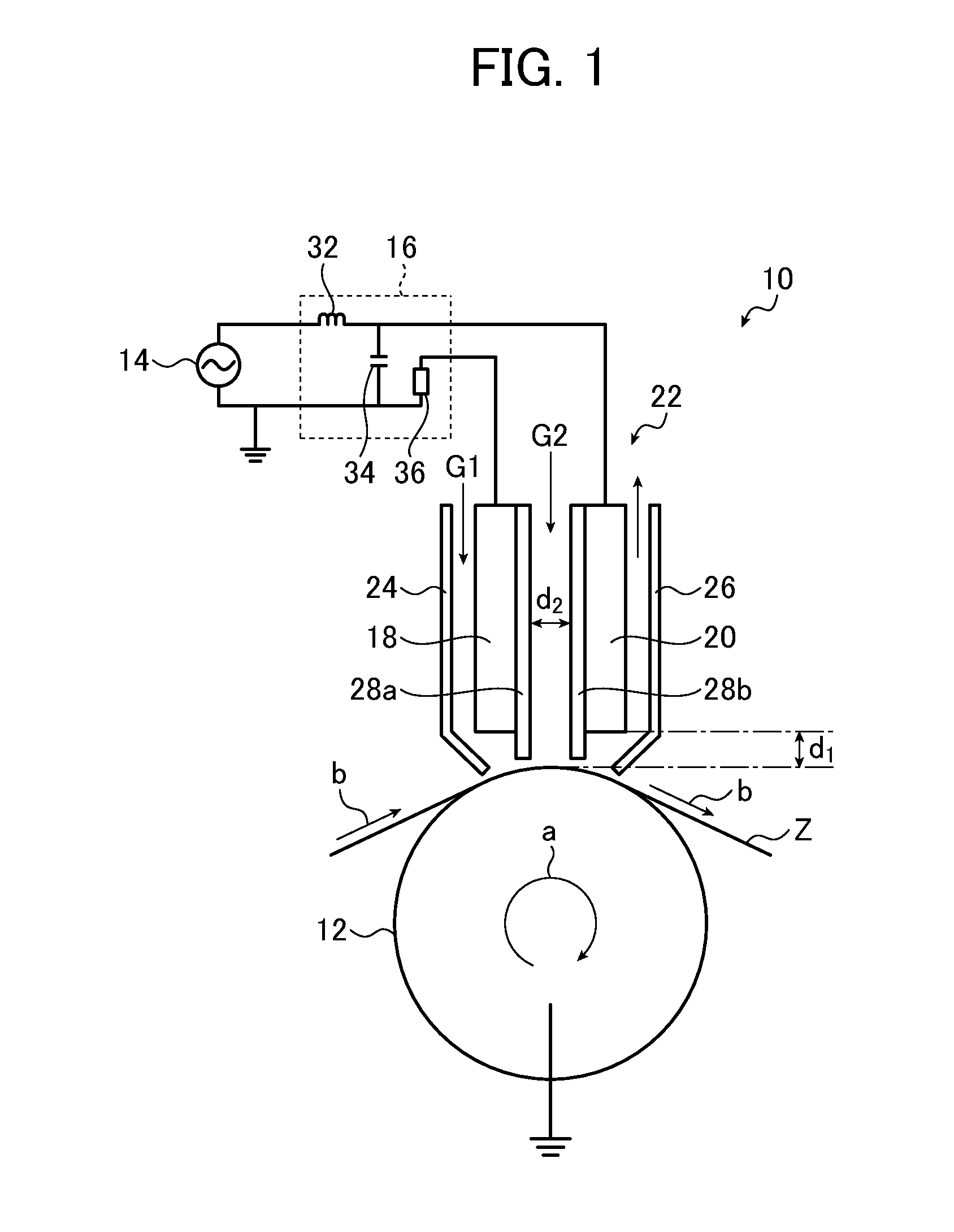Method of manufacturing transparent conductive film
a technology of transparent conductive film and manufacturing method, which is applied in the direction of oxide conductors, non-metal conductors, plasma techniques, etc., can solve the problems of decreased film quality, increased resistance, and increased resistance, so as to achieve higher light confinement effect and value of ra
- Summary
- Abstract
- Description
- Claims
- Application Information
AI Technical Summary
Benefits of technology
Problems solved by technology
Method used
Image
Examples
example 1
[0102]The film formation apparatus 10 shown in FIG. 1, which performs film formation by atmospheric pressure plasma-enhanced CVD by dielectric barrier discharge (DBD), was used to form a zinc oxide transparent conductive film with a thickness of 150 nm on the surface of a substrate Z.
[0103]As the substrate Z, a polyimide film with a thickness of 0.1 mm was used.
[0104]As the oxygen atom supply gas G1, 99.999% oxygen was used. The oxygen atom supply gas G1 was made to flow at a rate of 10 liters per minute, and by passing it through a UV radiation device, ozone was generated and then supplied between the flow path member 24 and the insulating plate 28a. Note that the UV radiation device irradiated ultraviolet light of 185 nm and 254 nm using the ozone lamp NIQ120 / 44U made by Heraeus. The radiation intensity was 0.06 W / cm2.
[0105]Diethyl zinc (Zn(C2H5)2) was supplied (4 g / hour) as a liquid to a vaporizer and was vaporized while heating to 100° C., and this was used as the gaseous raw ma...
example 2
[0111]A zinc oxide transparent conductive film with a thickness of 150 nm was formed on the surface of a substrate Z in the same way as in example 1, except that trimethyl aluminum (TMAl) was used instead of Al(DIBM)3 as the gaseous raw materials (film forming material).
[0112]Note that TMAl was supplied (0.1 g / hour) to the vaporizer as a liquid at 100° C., and it was vaporized while being sprayed, to form the gaseous raw material. Using nitrogen gas as a carrier gas (flow rate 2 L / minute), the vaporized TMAl was supplied between the insulating plates 28a and 28b, and it was mixed with diethyl zinc to form the film forming gas G2.
[0113]The film formation rate was 1200 nm / minute.
example 3
[0114]A zinc oxide transparent conductive film with a thickness of 150 nm was formed on the surface of a substrate Z in the same way as in example 1, except that Zn(OD)2 was used instead of diethyl zinc as the gaseous raw material (film forming raw material).
[0115]Note that a toluene solution of Zn(OD)2 in a concentration of 0.05 mol / L was used to supply Zn(OD)2. This solution was introduced into the vaporizer at a flow rate of 0.1 g / hour, and by heating it to 200° C., the Zn(OD)2 was vaporized, and gaseous raw material was obtained. Using nitrogen gas as a carrier gas (flow rate 2 L / minute), this gaseous raw material was supplied between the insulating plates 28a and 28b, so as to hold the pressure inside the vaporizer at 0.01 MPa above atmospheric pressure, and it was mixed with Al(DIBM)3 to form the film forming gas G2.
[0116]The film formation rate was 1100 nm / minute.
PUM
| Property | Measurement | Unit |
|---|---|---|
| temperature | aaaaa | aaaaa |
| distance | aaaaa | aaaaa |
| distance | aaaaa | aaaaa |
Abstract
Description
Claims
Application Information
 Login to View More
Login to View More - R&D
- Intellectual Property
- Life Sciences
- Materials
- Tech Scout
- Unparalleled Data Quality
- Higher Quality Content
- 60% Fewer Hallucinations
Browse by: Latest US Patents, China's latest patents, Technical Efficacy Thesaurus, Application Domain, Technology Topic, Popular Technical Reports.
© 2025 PatSnap. All rights reserved.Legal|Privacy policy|Modern Slavery Act Transparency Statement|Sitemap|About US| Contact US: help@patsnap.com


